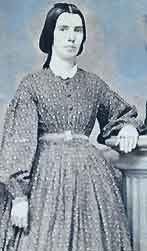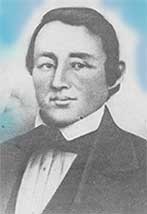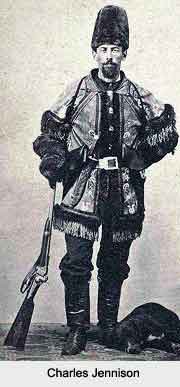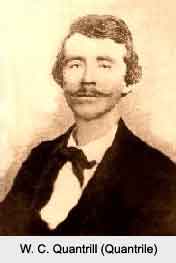Historical
Notes:(Revised Sep 2006, Oct 2006, Dec 2007)
There
are 41 letters in this section. Not every letter is mentioned in
the history below. Each of the
letters can be read in full from the index at the right.
(To
return to the website's Main Menu click here or
scroll down.)
1861 - 1865: The Civil War
By April 1861 the United States of America was
being torn apart by dissention between the North and the South states
rights and slavery. The southern States had formed the Confederate
States of America and up to this point South
Carolina, Mississippi, Florida, Alabama, Georgia, Louisiana and
Texas had left the Union and the Missouri Legislature was meeting to
decide
the fate of Missouri. Margaret Watts Hays'  concerns
are mainly with her family, for the areas around Westport in Jackson
County, Missouri
was peaceful and Upton, concerns
are mainly with her family, for the areas around Westport in Jackson
County, Missouri
was peaceful and Upton,  she wrote, was more concerned about loosing
his government freight contracts than the impending war. When Missouri
Secessionists seized the Liberty Arsenal in April 1861 it was the
beginning of
armed rebellion in Missouri. The raising of the Secessionist flag
in Kansas City is mentioned but there is no indication that Upton
was involved. Arkansas seceded from the Union on May 6th heightening
the tension of Missourians in this waiting period. In her May 11th
letter Margaret worries that if Missouri secedes the people in
Kansas will retaliate for the depredations by Missourians during the
Kansas-Missouri Border War of the 1850’s.
During May, North Carolina and Virginia seceded from the Union.
Margaret reported in her June 6th letter that Texas and Arkansas were
sending
troops to help Missouri fight her way out of the Union and the
Indian tribes, Shawnees and Cherokees (1),
were also sending men to the Confederacy. Tennessee seceded from
the Union on June 8, 1862. she wrote, was more concerned about loosing
his government freight contracts than the impending war. When Missouri
Secessionists seized the Liberty Arsenal in April 1861 it was the
beginning of
armed rebellion in Missouri. The raising of the Secessionist flag
in Kansas City is mentioned but there is no indication that Upton
was involved. Arkansas seceded from the Union on May 6th heightening
the tension of Missourians in this waiting period. In her May 11th
letter Margaret worries that if Missouri secedes the people in
Kansas will retaliate for the depredations by Missourians during the
Kansas-Missouri Border War of the 1850’s.
During May, North Carolina and Virginia seceded from the Union.
Margaret reported in her June 6th letter that Texas and Arkansas were
sending
troops to help Missouri fight her way out of the Union and the
Indian tribes, Shawnees and Cherokees (1),
were also sending men to the Confederacy. Tennessee seceded from
the Union on June 8, 1862.
By May of 1861 Missouri State Guard (1a) companies
under the command of Col. Edmund B. Holloway were being formed in Jackson
County. William Clarke Quantrill formed a small
company south of Independence. By July, Upton Hays had joined the State Guards
with the rank of Captain and then had fought in a battle against Union forces
at Carthage, Missouri. Upton Hays and the men of the Westport
area organized a company to protect the neighborhood from Jayhawker attacks
for as Margaret had feared, the Kansas Jayhawkers were riding into the Missouri
border counties from Kansas burning, pillaging and freeing slaves. The companies
of State Guards were called Partisan Rangers.
The elected Missouri Legislature was disbanded and a pro-Union Legislature
and governor were in control. The disbanded Legislature led by Governor Claiborne
Fox Jackson (2) continued to function as it moved south through Missouri, harassed
by Union troops. This created a very confusing situation for Missourians, for
they had two state governments both insisting that they were the legal authority.
General Sterling “Pap” Price was put in charge of the Missouri
State Guards and was recruiting men for the Confederate cause as at the same
time the Union–backed legislature was recruiting men into the Missouri
Home Guards and Union Army. On November 2, 1862 Jackson’s Legislature voted
to secede from the Union, a move that the Federal Government did not recognize
so that Missouri was still considered a part of the Union although they had representatives in the Confederate States Legislature. Margaret wrote in
September 1861 that Jayhawkers had been attacking all around their farm for
several weeks, plundering and taking off negros., the ports on the Missouri
River had been blockaded and she was expecting to be attacked by Jayhawkers
soon. At one time sixteen houses could be seen burning from the Hays' farm
two miles south of Westport.
On Oct. 21, 1861 a company of Jackson Co. men under Upton Hays and/or Richard Francis (Dick) Yager rode to Gardner, Johnson Co., Kansas and took the merchandise from two stores, one owned by I. W. Sponable and the other by Sanford B. Sponable and L. H. Church. (2a). It was well known that Kansas merchants were receiving the goods plundered from Missourians by the Kansas Jayhawkers and 'Dick' Yager's father's farm was one that had been robbed. (see Letter 34)
By the 4th of December the Hays’ house has been burned and their possessions
stolen or destroyed. Margaret and the children were living with Linville Hays, Upton’s
brother. Margaret was pregnant with her fifth child which she would have in
January 1862 and she was worried that Linville’s house would be burned
because he had taken in a Secessionist.
The worst of these plunderers was Charles Jennison, who began leading bands
of abolitionists on raids into Missouri in the late 1850’s. By the end
of 1861 he was the Colonel of the 7th Kansas Volunteer Cavalry, Jennison’s
Redlegs or Jayhawkers. Jennison had confiscated one of Upton Hays’ wagon
trains in 1860 or 1861 and had set himself up as a wagonmaster. There was probably
some personal animosity between Hays and Jennison. His group killed rebels
indiscriminately; old men and boys were dragged from their homes and shot or
hanged. His men plundered and destroyed homes and farms of people suspected
of supporting the Southern cause, and sometimes loyal people, too. After the raid on Gardner, Kansas, the merchants had asked Jennison to retaliate and it's likely that the burning of the Hays' home and destruction of their property was in retaliation for the Gardner raid. Neither
the United States authorities nor the Missouri government curbed these excesses until 1863.
He was very likely the most hated man in Jackson Co., Missouri for many years. raids into Missouri in the late 1850’s. By the end
of 1861 he was the Colonel of the 7th Kansas Volunteer Cavalry, Jennison’s
Redlegs or Jayhawkers. Jennison had confiscated one of Upton Hays’ wagon
trains in 1860 or 1861 and had set himself up as a wagonmaster. There was probably
some personal animosity between Hays and Jennison. His group killed rebels
indiscriminately; old men and boys were dragged from their homes and shot or
hanged. His men plundered and destroyed homes and farms of people suspected
of supporting the Southern cause, and sometimes loyal people, too. After the raid on Gardner, Kansas, the merchants had asked Jennison to retaliate and it's likely that the burning of the Hays' home and destruction of their property was in retaliation for the Gardner raid. Neither
the United States authorities nor the Missouri government curbed these excesses until 1863.
He was very likely the most hated man in Jackson Co., Missouri for many years.
During late 1861 and early 1862, Upton Hays accompanied Governor Jackson’s
withdrawal into Arkansas. Upton’s enlistment with the State Guards ended
in February 1862 and he went to Texas and rented a farm. He then returned to
Arkansas and tried to take his family to Texas but was unable to get his family
out of Missouri. He became a Lieutenant Colonel of the 2nd Missouri Cavalry,
CSA(3), under General Hindman and Col. Joe Shelby. When in Arkansas he stayed
with his cousin Eliza Hays Word in Ft. Smith. He made forays and recruiting
missions into Missouri with his men where he stayed mostly with relatives and
visited his family whenever possible. In August 1862 Upton Hays and Quantrill
issued a joint Proclamation to the people of Missouri. It read:
Proclamation(4)
Whereas the Federal Government
has issued an order calling upon all male citizens between the ages
of
eighteen and forty five to come forward and enroll their names preparatory
to drafting men to reinforce the lately defeated army before Richmond.
We proclaim to all men if they will come to any of the many camps
now in the brush they will be furnished with arms and ammunition with
which to [the bottom of the page is missing]
(side 2)
Any man who shall be found guilty of reporting to any military
post the where bouts of any southern person shall be shot.
Anyone liable to military duty who shall leave the state or shall
be found preparing to leave the state to prevent being called into
the
service will be deemed enemies of the South and be treated accordingly.
To the State of Upton Hays
Missouri W. C. Quantrile
Aug 4/ 62
 Although the United States had not recognized the succession of Missouri,
the Confederate States of America accepted Missouri as a Confederate
State. Both
sides had instituted a draft of men for their armies, and there were severe
penalties if men did not join. The United States was in military control
of most of Missouri and enforced loyalty through requiring loyalty
oaths, imprisonment,
and requiring men to join the army, posting bond and exile from certain areas.
Confederate recruiters traveled through Missouri accepting men and sending
or taking them south and keeping the irregular troops, guerillas, informed.
When caught they were often hanged as spies. The irregular forces, although
their main mission was to disrupt the Union Army occupation of Missouri,
did attack and kill civilian Union sympathizers, burn houses, destroy
property
as the Kansas Union Jayhawkers and Redlegs were doing along the Kansas-Missouri
border. Although the United States had not recognized the succession of Missouri,
the Confederate States of America accepted Missouri as a Confederate
State. Both
sides had instituted a draft of men for their armies, and there were severe
penalties if men did not join. The United States was in military control
of most of Missouri and enforced loyalty through requiring loyalty
oaths, imprisonment,
and requiring men to join the army, posting bond and exile from certain areas.
Confederate recruiters traveled through Missouri accepting men and sending
or taking them south and keeping the irregular troops, guerillas, informed.
When caught they were often hanged as spies. The irregular forces, although
their main mission was to disrupt the Union Army occupation of Missouri,
did attack and kill civilian Union sympathizers, burn houses, destroy
property
as the Kansas Union Jayhawkers and Redlegs were doing along the Kansas-Missouri
border.
Margaret Hays wrote that Upton’s life was in great danger; the Union
Military Command wanted him dead or captured and Margaret was in danger of
being imprisoned. She had moved back to an old house on their farm and it
was burned, the fences and crops destroyed, all of the animals killed and
the Redlegs
carried away anything of value she had saved. Upton was killed in a skirmish
with Union pickets near Newtonia, Missouri in September 1862(5).
In 1863 Margaret Hays and her children lived in a small house on the Hays
farm until she was exiled from Jackson Co. by Order 11(6). Margaret and her
four children
moved to Williamsburg, Callaway Co., Missouri and lived there supported by
relatives and friends until the end of the Civil War. The day after she left
Jackson Co., her last home was burned. Although her home had been burned and her possessions plundered by
the
Kansas
Jayhawkers, a few treasures that she had hidden
out in the “brush” survived and among them was a wooden yardstick, a plain round stick marked off at foot intervals with the initias N H carved at the end, which had been a gift to her mother from Nancy Hanks, Abraham Lincoln’s mother.
The Civil War in California was not as violent as it was in Missouri. Although
there were many Confederate sympathizers, they were not in the majority and
the Union Army had acted early and gained control of the state. More than
8000 men who joined the Union Army were sent to take control of the Arizona
and
New Mexico Territories which had been occupied by Confederate forces. A number
of Confederate supporters were jailed and newspapers supporting the South
were attacked and their offices and presses destroyed. The assassination
of President
Linclon in April 1865 led to considerable unrest as the celebrating rebel
supporters clashed with Union supporters. The area around Danville, Contra
Costa Co.,
the home of Hays, Yager and Berry relatives of Elizabeth Watts and Margaret
Watts Hays were strongly for the Confederacy.(7)
Margaret Hays remained in Jackson Co., Missouri until 1872 when she and her children left for California to join her mother and brothers in Mariposa. In 1873 she homesteaded a farm in Tulare County (later Kings County), California near Hanford and in 1877, married William B. Overstreet, an acquaintance from Missouri. They had one son, Claude C. Overstreet. Margaret died May 6, 1923 and was buried in the Grangeville Cemetery, Armona, Kings Co., California.
.
Some of Margaret and Upton’s
relatives who died in this conflict were:
Cousin John W. Berry Confederate 1863
Cousin Caleb Ewing Berry Union 1861
Nephew Thomas A. Yocum Confederate 1862 Battle of Corinth, Mississippi
Nephew Travis G. Yocum, Confederate 1862, Battle of Corinth, Mississippi
Husband Upton Hays Confederate 1862 Newton Co., Missouri
Cousin Richard Samuel Kimberlin Civilian 1862 Jackson Co., Missouri
Cousin Richard D. Berry Civilian 1863 Cass Co., Missouri
Cousin Beverly James Dickerson Civilian 1863 Johnson Co., Illinois
Cousin Richard Frances Yager Confederate 1864 Saline Co., Missouri
Cousin Abraham Lincoln Union 1865 Washington, D. C.
Niece’s husband Henry Clay Rout Confederate 1863
Cousin James R. Gashwiler Confederate 1862 Mississippi
Cousin Richard Hays Confederate? 1861
Cousin Thomas W. Benson Union Before 1865
Cousin John Wesley Benson Confederate 1862 Pea Ridge/Elkhorn Tavern, Arkansas
Cousin Daniel Boone Scholl Confederate 1863 Jackson Co.. Missouri
“Uncle” William Bryant Civilian 1863 Jackson Co., Missouri
“Cousin” Samuel B. Collins Confederate 1862 Pea Ridge/Elkhorn Tavern,
Missouri
Charles Hamilton, Jr. Confederate 1863, Cass Co., Missouril
Robert S. Hamilton Confederate 1861 Battle of Morristown, Cass Co., Missouri
Cousin Daniel Boone Muir Civilian Jackson Co., Missouri, Jayhawker raid
Cousin Samuel McMurtry Confederate 1864
Relatives Imprisoned or captured:
Uncle James B. Yager Civilian Gratiot Prison, St. Louis, Missouri, posted bond, released
Rev. John W. Gashwiler Civilian Gratiot Prison, St. Louis, Missouri, posted bond, released
Cousin’s wife Martha Muir Yager Civilian Kansas City, Missouri, exiled
John Edward Berry Confederate Alton Prison, IL, Ft. Delaware, exchanged
James R. Gashwiler, Confederate Alton Prison, Illinois; Johnson Island, Ohio
James Samuel Berry Confederate Vicksburg, Mississippi, paroled
Isaiah Jefferson Kimberlin Confederate Sedalia, Missouri, escaped
John Watts Murray, Confederate, released after taking the Oath of Allegiance 1864
Other relatives who served in the Civil War:
Lafayette Benson Confederate 1st Reg., Cavalry Volunteers, Missouri State
Guards
Thomas W. Benson Union 10th Reg., Missouri Infantry
Isaac F. Berry Confederate 1st Reg., Missouri Cavalry State Guard (8th
Division), Quantrill
James Samuel Berry, Confederate 12th (2nd) Missouri Cavalry
James Berry Confederate Cavalry 12th (2nd) Regiment, Missouri Cavalry, Quantrill
James Tate Berry, Union Osage Co. Home Guards, 2nd Reg., Missouri Light Artillery,
26th Reg., Missouri Infantry
John D. Berry, Union Osage Co., Home Guards, Union, 2nd Reg. Missouri Light
Artillery
John Edward Berry, Confederate State Guards , 6th Missouri Infantry, Irwin’s
Reg., Freeman’s Co.
Richard Berry Confederate 12th (2nd) Regiment, Missouri Cavalry, Anderson,
Quantrill
Richard C. Berry, Jr., Confederate, Missouri State Guards, 2nd Reg.
Robert Mitchell Berry, Union State Guards, Callaway Co., Missouri
Robert Mitchell Berry, Union Osage Co. Home Guards, , 26th Reg. Missouri
Infantry
Samuel H. Berry Confederate, William’s Reg. Cav.
Hardin Chick Confederate Robertson's Reg. State Guards, PVT, Snider's Batt.,
MO Cav, Clark's Reg, MO Inf.
James Chick Confederate 6th Missouri Cav. (Williams Reg.)
Amazon Collins Confederate 6th MO Cav. (William's Reg.) Lt. Col. Hodge
Grant W. Dickerson, Confederate 7th Regiment, MO Cavalry, Pvt.
James Marion Dickerson, Union Howard Co. (MO) 2nd Bat. EMM, Co. D, Corp.
Discharged/exiled from state
John D. Dickerson, Confederate Cavalry, Poindexter's Regiment, Missouri Cavalry,
Pvt., Quantrill
Paul Dickerson Confederate Quantrill
Warrington C. Dickerson Confederate. Poindexter's Reg. Missouri Cav., Pvt., Union Doziers' Boone County VMM
Linville Hays Confederate Shelby’s Div., 6th MO Cav. (Williams'
Regiment) , Pvt., Lt. Cmdr Milton Scholl and Union Co. E. 77th Regiment
Enrolled Missouri Militia, discharged, exiled
from state
William Hays Confederate 1st Regiment Cavalry Volunteers CSA, Quantrill
James G. Johnson Confederate Co. C, 4th Reg Cav, MO State Guard, 2nd Lt. – Captain
(Hunter’s Reg. Mo Cav)
George Washington Johnson Confederate. State Guard (Miller Co.?)
Edward Johnson Confederate (3 Missouri Inf., Co. B ?)
Isaiah Jefferson Kimberlin Confederate 12th MO Cavalry, Pvt. Co. D (Shank's Regiment)
Julian N. Kimberlin, Confederate 12th MO Cavalry, Co. D, Water Boy
Richard Samuel Kimberlin, Jr. Confederate 12th MO Cavalry, Pvt Co. D (Shelby's Brigade)
William Grant Kimberlin Confederate 12th Missouri Cavalry, Pvt. Co., D
John B. Kurtz (Curtz) Confederate 6th Regiment Infantry Volunteers, Co. I., CSA
Littrell, James Harrison Union 61 Reg., Enrolled Missouri Militia, Pvt. Co. H, Capt Richie and possibly Confederate 6th/11th Missouri Cav., Pvt., Col Coffee
Littrell, Tolbert/Talbot Confederate CSA, Pvt.
John P. Lowe Confederate Co. F., 1st Missouri Cavalry (Capt. Thrailkill)
Samuel McMurtry Union Co. F. 3rd Reg, Enrolled Missouri Militia and Confederate
Boone T. Muir Confederate Quantrill, Younger
Samuel B. Muir Confederate Quantrill
John Watts Murray Confederate 11th(8th) Missouri Inf. Co. D, Hunter's Reg.
John Bunyan Rowland Union Cass Co. Home Guard, 14th Reg. Kansas Cavalry
Daniel Boone Scholl Confederate Quantrill
James Westlake Shafer Union 9th Indiana Infantry
John Finley Shafer Union 51th Indiana Infantry Co. B, Corporal
Joseph Shafer Union 51th Indiana Infantry, Co. E, Pvt.
Martin Van Buren Sheafor Union 4th Iowa Cavalry, Co. M
Peter Messick Sheafor Union 8th Iowa Cavalry, Co. L, Pvt., Sgt.
William B. Sheafor Union 10th Missouri Cavalry Co. D
Andrew Jackson Watts Union Co. I, 9th Kentucky Cavalry
James Marion Watts Union Missouri State Military (Cavalry) Co M, 1st Reg.
(Thomas) Jefferson Watts Union Co. H, 115 th US Cavalry Kentucky
William R. Watts, Jr. Union, Co. F, 7 A 26 Kentucky Inf., Co. A 33 Kentucky Inf.
Thomas A. Yocum Confederate 1st Reg. Cav. Vol., Co.I, Missouri State Guards, 6th Missouri
Reg. Infantry Vol. Co. A, Sgt.
Travis G. Yocum Confederate 10th Reg. Cav. Vol. Co. F, Pvt and MSG, 6th Mo Reg.
Inf. Vol. Co. A, Pvt.
William N. Young Confederate 6th Missouri Infantry, Co. A, Sgt. , Coleman's Reg. Missouri Cavalry
[notes and abbreviations: Quantrill, Anderson and Younger - Irregular or Guerilla Confederate units. MSG - Missouri State Guards. Inf.
- Infantry. Cav. - Cavalry. Reg. - Regiment. Co. -
Company. EMM - Enrolled Missouri Militia. Pvt. - Private. Sgt. - Sergeant. Lt. - Lieutenant. Capt. - Captain. Col.- Colonel.
Information about the men
was found at the National Park Service Soldiers and Sailors System, the Missouri
State Archives and other online soucres]
Footnote
1. Website: Chickasaw Nation
www.lindasloveables.com.five_great_nations.htm
Moore, Jesse E., Five Great Nations, Southern Magazine Vol. III, No.2,
February 1936.
When the Southern States seceded and the war drums were beating, the Federal
Government in 1861, ordered that all Forts in Indian Territory must be abandoned.
This order was promptly obeyed and the Federal troops marched north under
the command of Colonel William H. Emory, thereby abrogating the solemn Treaties
and leaving the Five Nations at the mercy of the Plains Indians. (back)
In 1861, President Jefferson Davis, of the Confederates States of America,
appointed General Albert Pike, Commissioner of all of the Indians west of
Arkansas and south of Kansas, because of his friendship and influence with
the leading
Indians of that district. He was delegated with plenary powers to secure
the assistance of the Cherokees, Choctaws, Chickasaws, Creeks and Seminoles,
in
Indian Territory.
General Pike met the delegates selected by the Five Nations
in Convention assembled at North Fork Town, on the north fork of Canadian River,
in the Creek Nation,
on the twentieth day of July, 1861. The delegates from the Choctaws, Chickasaws,
Creeks, and Seminoles pledged their various Nations as friends to the Confederate
States of America and entered into treaty of friendship and alliance.
The National Governments ratified these treaties at once and
officers were commissioned to raise troops.
The Cherokees, while just as enthusiastic, were more deliberate
and on August 12, 1861, pledged their friendship and entered into a Treaty of
alliance although
the formal Treaty was not signed until October 9, 1861.
Footnote 1a. Missouri State
Guard companies was formed in each county by order of the State Legislature.
Many of the units
later joined the Cofederate Army. The Missouri Home Guards were formed after
the elected legislature had been disbanded and a Union-backed legislature had
taken control of the state government (back).
Footnote
2. This
is what Claiborne Jackson said to the state of Missouri in his June 12, 1861
proclamation: All our efforts toward conciliation have
failed.
We
can hope nothing from the justice or moderation of the agents of the Federal
Government in this State. They are energetically hastening the execution
of their bloody and revolutionary schemes for the inauguration of civil war
in
your midst; for the military occupation of your State by armed bands of lawless
invaders; for the overthrow of your State government; and for the subversion
of those liberties which that Government has always sought to protect; and
they intend to exert their whole power to subjugate you, if possible, to
the military despotism which has usurped the powers of the Federal Government...You
are under no obligation whatever to obey the unconstitutional edicts of the
military despotism which has enthroned itself in Washington, not to submit
to the infamous and degrading sway of its wicked minions in this State...Rise,
then, and drive out ignominiously the invaders who have dared to desecrate
the soil which your labors have made fruitful, and which is consecrated by
your homes. [ Bushwackers
and Jayhawkers: Uncivil Missouri and Kansas] (back)
Footnote 2a. see
History of Johnson County (KS), Chapter 8, Page 140 http://www.kancoll.org/books/blair/blchapter08.htm and
Kansas, a cyclopedia of state history
http://skyways.lib.ks.us/genweb/archives/1912/g/gardner.html (back)
Footnote 3. The terms of
service could be either 12-month cavalry, who would outfit and equip themselves,
or infantry, who would sign on for three years
or the
duration of the war, to be equipped with arms by the Confederate government. (back)
Footnote
4. A handwritten copy of the Proclamation
is in the Missouri Valley Special Collection, Kansas City (Mo.) Public Library.(back)
Footnote
5. There are several versions of Upton’s
death. The most likely is that while on patrol he rode ahead of his men accompanied
by Sy Porter.
They
encountered Union pickets and Upton Hays rode toward them attempting to fire
his pistol, but the powder was wet and the gun did not fire. A Union picket
shot him in the head. His men buried him.(back)
Footnote
6. Order No. 11 was issued 25 Aug 1863
by Union Brig. Gen. Thomas Ewing, Jr. The Confederate guerillas were being
aided and supported by the
people
of the Missouri-Kansas border counties. This order exiled all Confederate
supporters from Jackson, Bates and Cass Counties in Missouri to eliminate
the civilian
support of the guerillas. The homes and property destroyed and stolen after
the people left was done by Kansas Jayhawkers who took advantage of the unprotected
property. (see: Albert Castel, Order No. 11 and The
Civil War on the Border,
1963. (back)
Footnote
7. For more information see “Snakes
in the Grass, Copperheads in Contra Costa” by William Mero. (back)
back to top |
